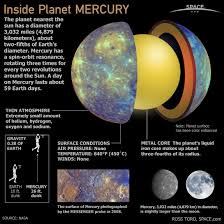Overview
The planet Mercury is the closest planet to the Sun in the solar system. It is much smaller than the Earth, but has similar chemical composition. Although the planet Mercury was known to ancient civilizations, it contains many mysteries. Much information has been learned from space probes flying by the planet.
Location
Mercury is the closest planet to the Sun in the solar system. It is about 35,980,000 miles (57,910,000 km) from it, with an orbit that lasts about 88 Earth days. It is so close to the Sun that its average temperature on the day side is about 430°C (800° F). For every two orbits, it rotates three times, so that a day on Mercury is about 59 Earth days long. Tidal forces slow its rotation so that the temperature on the night side averages -180°C (-290° F).
Composition
Mercury is a rocky planet, similar to the Earth, slightly larger than the moon. It has an iron-nickel core that is probably about three-fourths of the entire planet, and is still molten due to the magnetic field. The planetary shell consists of various silicates. There isn’t an atmosphere, because any atmosphere that could collect is vaporized by intense solar radiation. Mercury has a small exosphere that consists of atoms that are blasted away from meteor impacts and solar winds that create tornadoes. The surface is cratered like the Moon, but most of the craters are shallow. One large meteor probably caused a huge crater called the Caloris Basin.
Observations of Mercury
The planet Mercury was first observed by ancient Assyrians, Chinese, in India, and in Greece. The Romans named the planet after the messenger god because it appeared to move so quickly across the night sky. Since it is so close to the sun, the planet was very difficult to observe. Most of the information about Mercury has come from space probes. The Mariner 10 mission used the gravity of the planet Venus to propel it like a slingshot past the planet Mercury. The magnetic field was a surprise to scientists, because it was thought that the planet spun too slowly to have one. There also may be more volcanic activity than was once thought.
MESSENGER brought more Surprises
The MESSENGER space probe was developed as a mission specifically to the planet Mercury, combining a flyby with orbits of the planet. It began orbiting Mercury in 2011, and its mission will end in April 2015, when it will run out of fuel and crash. It has produced many detailed pictures of Mercury’s craters, mapped its magnetic field, and measured the chemical elements that make up the planet. Some of the craters near Mercury’s poles have deposits of frozen water that has not melted or evaporated. Scientists think that icy deposits may have come from comets that impact it, so it may have been there for billions of years. Also, carbon from passing comets have made the surface of Mercury much darker and less reflective that other planets in the solar system.
Interested in science tutoring services? Learn more about how we are assisting thousands of students each academic year.
SchoolTutoring Academy is the premier educational services company for K-12 and college students. We offer tutoring programs for students in K-12, AP classes, and college. To learn more about how we help parents and students in Lowell, MA: visit Tutoring in Lowell, MA





